|
|
|
 |
Main Features |
|
|

- Available as 2 / 4 or 8 channel multiplexed programming system
- Supports sequential programming of 2 / 4 or 8 UUTs (depending on programmer model)
- A single 'ISPnano Series 3' programmer is multiplexed sequentially to up to 8 individual Target Boards (UUTs)
- All programming signals are multiplexed to each UUT using high-quality analogue switches
- All programming signals are fully ESD and over-voltage protected
- All passive / power signals (Target VCC, Target Vpp and EXT-VCC power signals) are switched via individual high-quality relays to each UUT
- Power is always switched off to the target UUT before switching to the next UUT thus providing very long relay contact life
- Each programming channel features its own interchangeable 'I/O Connector Module' with relays and any custom target connectors
- Status indicators include - current channel being programmed and PASS / BUSY / FAIL
- Controllable via a PC using the Equinox EDS, ConsoleEDS or ISP-PRO software utilities
- Channel multiplexer control can be controlled either via the PC or a remote system
|
 |
Programmer – Target I/O Signals |
|
|
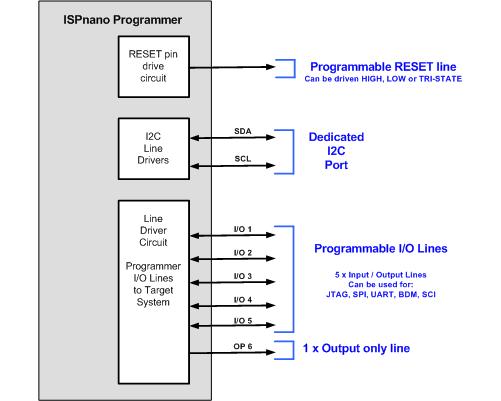
The ISPnano features the following programmable signal lines which interface the programmer and the Target IC(s) to be programmed on the Target System:
• 5 x Programmable Input / Output lines
• 1 x Programmable Output only line
• 1 x Dedicated I2C (Two Wire Interface) port
• 1 x Dedicated RESET pin with user-defineable push-pull control
• 1 x Programmable 32.771 kHz Oscillator Output for Oscillator Calibration on Programmer I/O1 pin
|
 |
Front Panel view |
|
|

|
 |
Target Connectors |
|
|
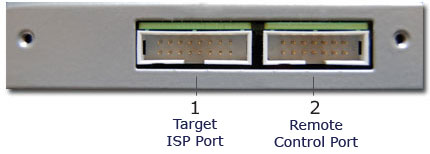
|
 |
Programmer Power and Communications Connectors |
|
|
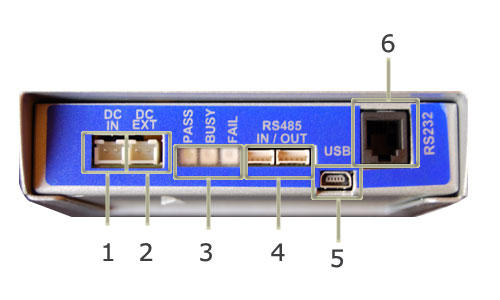
|
#
|
Connector Name
|
Description / comment
|
|
1 |
DC Power Input |
DC Power Input to power the programmer |
|
2 |
EXTERNAL TARGET VCC INPUT |
EXTERNAL TARGET VCC INPUT |
|
3 |
Programmer STATUS LEDs |
Programmer ‘Status’ LEDs |
|
4 |
RS485 Ports |
RS485 Ports (1) + (2) - Serial Communications Ports |
|
5 |
USB |
USB Port (mini-USB connector) |
|
6 |
RS232 Port (2)
or Remote Display Keypad |
RS232 Port (2) - Serial Communications Port |
|
 |
Programmer Power Supplies |
|
|
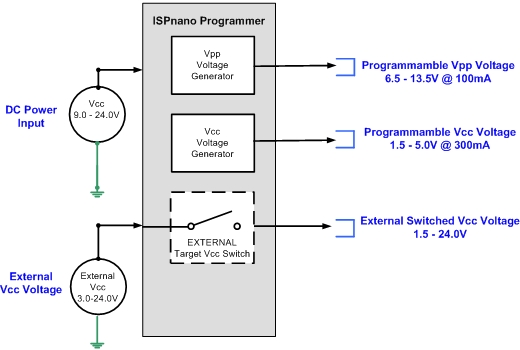
The ISPnano features the following on-board power supplies:
• 1 x Programmable Target Vcc Supply: 1.2 - 5.0V @ 300mA
• 1 x Programmable Target Vpp Supply: 5.8 - 13.5V @ 100mA
• 1 x External Vcc Voltage Supply (1.2V - 24.0V) switched to Target System
Power Supply features:
• Wide power supply input voltage range: 9.0V to 24.0V
• Short-circuit protected outputs
• Fast rise-time with enhanced current pumping capability to fast charge any capacitance on the Target System.
• Each power supply output (Vcc and Vpp) can be user-calibrated to a very accurate "spot voltage"
• Switchable Target Discharge Circuit - provides a fast discharge method for any capacitance on the Target System.
• Voltage measurement - supports measurement of Target Voltage, Line Driver Voltage and one External Voltage (1.2V - 30.0V)
• Current measurement - supports measurement of Target current on switch-on.
|
 |
Host Control connectivity (Communications Ports) |
|
|
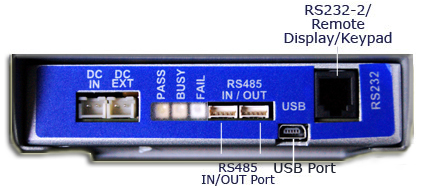
• 1 x High-speed USB Port (mini-USB connector)
• 1 x RS232 Serial Ports
• 1 x RS485 IN/OUT port – supports up to 32 programmers on an RS485 network
• 4-wire TTL Remote Control Port
• Remote Keypad / Display (ideal for standalone control in a Test Fixture)
|
 |
Gang ISP Programming / network programming support |
|
|
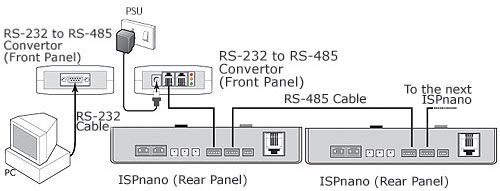
• Gang ISP Programming configuration is ideal for programming multiple PCB's on a 'PCB Panel'
• Up to 32 programmers can be controlled from a single PC using the RS485 Bus
• Compact size and network option allows up to 32 programmers to be mounted even in small fixtures.
|
 |
Standalone Programming Operation (no PC) |
|
|
The ISPnano programmer is capable of operating in ‘Standalone Mode’ i.e. without PC Control. In this mode a single 'Programming Project' or a set of 'Chained Projects' can be triggered using an external event. The programmer can be triggered to start a programming sequence using any of the following methods:
• [START] button on front panel
• 4-wire TTL Remote control Port (Ideal for ATE Remote Control)
• Target 'Load Sensing' Detection
• Test Fixture 'Lid Switch Sensing' (closes to start programming)
• Remote Keypad / Display mounted on the top of the Test Fixture
|
 |
Device Libraries |
|
|

To keep the overall system cost as low as possible, the ISPnano programmer does not come with any devices supported as standard. You can then simply purchase the 'Device Libraries' you need for your application from the list below.
Atmel
- AVR microcontroller SPI algorithms: AT90S, AT90CAN, AT90USB, ATtiny, ATmega
- AVR microcontroller JTAG algorithms: AT90CAN, AT90USB, ATmega
- ATtiny AVR microcontroller TPI algorithms: ATtiny TPI
- AT91SAM7 ARM microcontroller JTAG algorithms: AT91SAM7S, AT91SAM7SE, AT91SAM7X, AT91SAM7XC, AT91SAM7L, AT91SAM7A
- ATXMEGA microcontroller JTAG algorithms (due Q3 2010)
- ATXMEGA microcontroller PDI algorithms (Now available)
- AT45D Serial DataFLASH algorithms (due Q3 2010)
Zensys
- Zensys - Z-Wave: ZW0102, ZW0201, ZW0301
All manufacturers
- 24xxx Serial EEPROM algorithms (all manufacturers)
|
| |